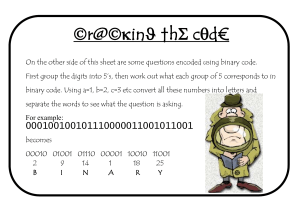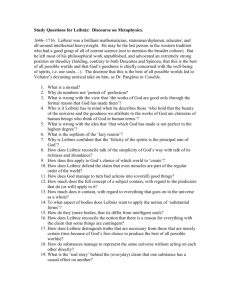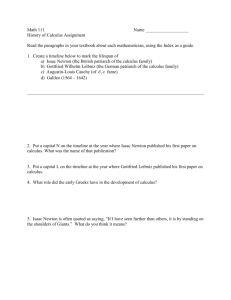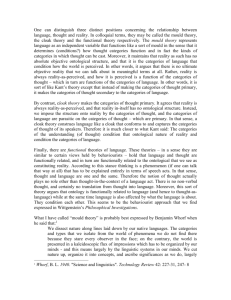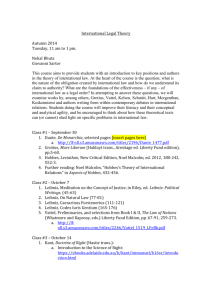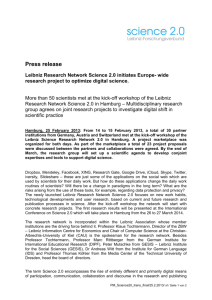Leibniz Final
advertisement
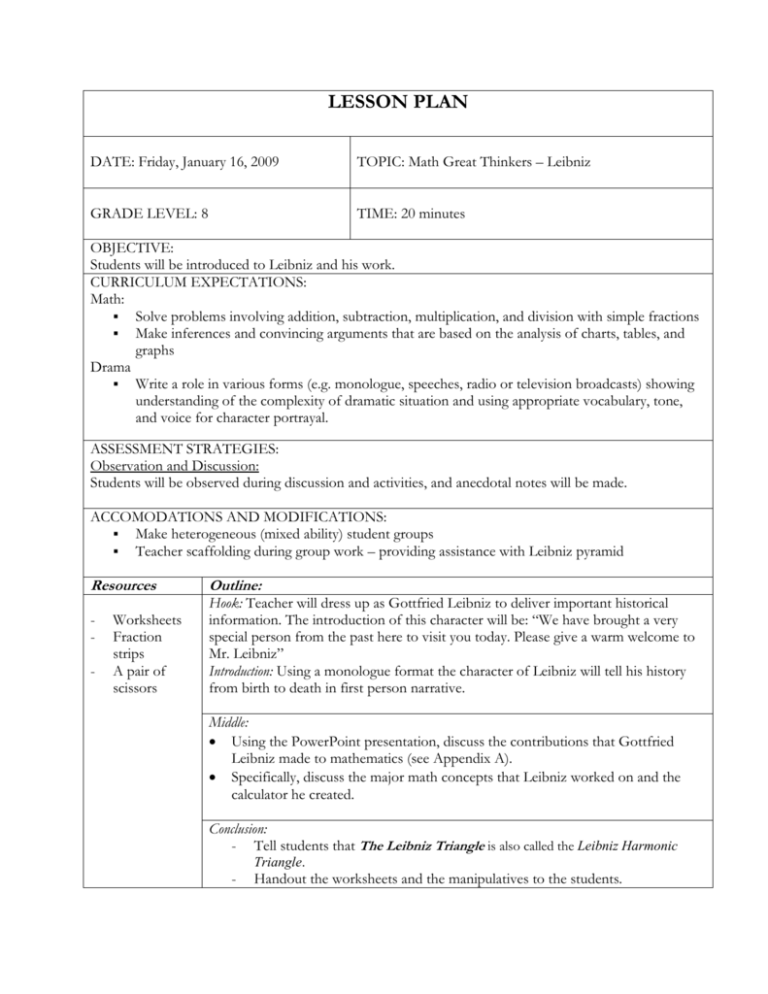
LESSON PLAN DATE: Friday, January 16, 2009 TOPIC: Math Great Thinkers – Leibniz GRADE LEVEL: 8 TIME: 20 minutes OBJECTIVE: Students will be introduced to Leibniz and his work. CURRICULUM EXPECTATIONS: Math: Solve problems involving addition, subtraction, multiplication, and division with simple fractions Make inferences and convincing arguments that are based on the analysis of charts, tables, and graphs Drama Write a role in various forms (e.g. monologue, speeches, radio or television broadcasts) showing understanding of the complexity of dramatic situation and using appropriate vocabulary, tone, and voice for character portrayal. ASSESSMENT STRATEGIES: Observation and Discussion: Students will be observed during discussion and activities, and anecdotal notes will be made. ACCOMODATIONS AND MODIFICATIONS: Make heterogeneous (mixed ability) student groups Teacher scaffolding during group work – providing assistance with Leibniz pyramid Resources - Worksheets Fraction strips A pair of scissors Outline: Hook: Teacher will dress up as Gottfried Leibniz to deliver important historical information. The introduction of this character will be: “We have brought a very special person from the past here to visit you today. Please give a warm welcome to Mr. Leibniz” Introduction: Using a monologue format the character of Leibniz will tell his history from birth to death in first person narrative. Middle: Using the PowerPoint presentation, discuss the contributions that Gottfried Leibniz made to mathematics (see Appendix A). Specifically, discuss the major math concepts that Leibniz worked on and the calculator he created. Conclusion: - Tell students that The Leibniz Triangle is also called the Leibniz Harmonic Triangle. - Handout the worksheets and the manipulatives to the students. - Ask the students to try to fill out the values in the triangle. Some values are already filled out for them. As a hint, tell them that the Leibniz Triangle follows a similar pattern to the Pascal’s triangle. Once students are done working explain how the triangle is filled out. A row of the Leibniz triangle starts with the reciprocal of the row number (or the row number plus one depending on whether one starts counting from 1 or 0.) Every entry is the sum of the two numbers just below it. The entries can thus be computed sequentially left to right and top to bottom using subtraction instead of addition. E.g., in the fifth row, 1/20 = 1/4 - 1/5, 1/30 = 1/12 - 1/20, 1/20 = 1/12 - 1/30, 1/5 = 1/4 - 1/20. Asymmetry of construction notwithstanding, the triangle is symmetric with respect to its vertical axis. Appendix A: Leibniz the Mathematician Leibniz is best known for his development of calculus, independently of Newton. Specifically, Leibniz introduced his notation for differentiation using dx and dy, the use of powers, products and quotients. Although he published his results slightly after Newton, his notation was by far superior (including the integral sign and derivative notation), and is still in use today. A controversy developed between Newton and Leibniz, and their supporters. There were accusations of plagiarism being hurled relentlessly towards Leibniz. While Newton had many allies rallying in his favor, Leibniz had only one: John Bernoulli. Today, they credit goes to both men. Two main ideas that Leibniz introduced were: 1) a universal language, and 2) a calculus of reason which would reduce all problems to numerical computation. Leibniz conceived of and attempted to design a lingua characteristica (a language in which all knowledge could be formally expressed) and a calculus ratiocinator (calculus of reasoning). In 1671, Leibniz created a mechanical calculating device after studying Pascal’s calculator. His calculator could be used to multiply and divide, functions that Pascal’s device could not do. Leibniz introduced the use of multiplier wheels and a delay carry mechanism in his calculator – methods used for the next 300 years. His machine is preserved in the State Library at Hanover, Germany. Other things he contributed to: o multiple indices to state the result of three linear equations o study of differential equations o discovering the method of separation of variables o reduction of homogeneous equations to separable ones o the procedure for solving first order linear equations o laid the foundations of the theory of determinants o integrated rational fractions in trigonometric and logarithmic functions o produced a theory of special curves o one of the first to work out the properties of the binary number system References: Weisstein, Eric W. “Leibniz, Gottfried (1646-1716)”. Wolfram Research. http://scienceworld.wolfram.com/biography/Leibniz.html (1996-2007). Jones, Roger B. “Leibniz and the Automation of Reason”. RBJones. http://www.rbjones.com/rbjpub/philos/history/xh003.html (1994-2008). O’Connor, J.J. and Robertson, E.F. “Gottfried Wilhelm von Leibniz”. MacTutor History of Mathematics http://www-history.mcs.st-andrews.ac.uk/Biographies/Leibniz.html (1998)
